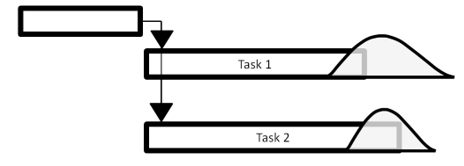Critical indexes play a pivotal role in Monte Carlo risk analysis for project schedules because they provide crucial insights into the sensitivity and reliability of the schedule. They help in understanding the impact of uncertainties on project schedules and, like the Critical Path, identify the activities that are most likely to significantly impact the project’s overall duration. These are the tasks that, if delayed, will directly affect the project’s completion date. Critical indexes also allow analysts to understand the likelihood of delays and identify which tasks are most susceptible to these uncertainties.
Here is an example of how the criticality index is calculated. In the project schedule below. Task 1 and Task 2 have uncertainties defined by a statistical distribution.
When we perform a Monte Carlo simulation of this schedule, what we will discover is that different iterations of the Monte Carlo simulation Task 1 will be on the critical path, but on other iterations, Task 2 will be critical. The Critical Index is an indicator which shows how many times the task is on the critical path during a Monte Carlo simulation.
By understanding which activities are critical, project managers can focus their efforts on managing, mitigating, or allocating resources more effectively to these tasks. It enables them to prioritize actions that will have the most significant impact on reducing overall project risk. This also allows teams and stakeholders to focus on where potential delays could occur in a project and formulate actions to minimize these risks, ensuring alignment and understanding among project teams and stakeholders. In our next blog, we will look at how Monte Carlos simulation is used to prioritize risks.


